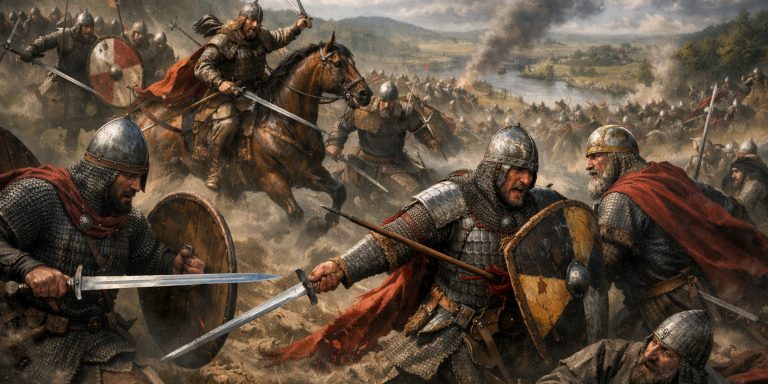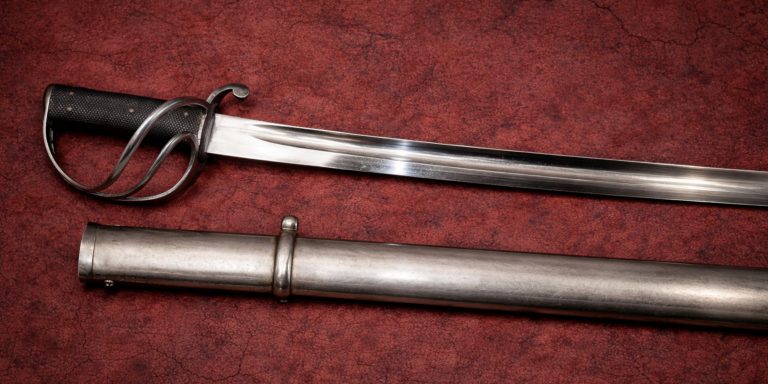
The Byzantine spathion was the sword of a civilisation that bridged the ancient and medieval worlds. Used by the Eastern Roman army from roughly the 6th to the 11th century, it represented both continuity and innovation. Deriving its name from the Greek spatha, meaning “broad blade”, the spathion was a descendant of the Roman spatha but adapted for the empire’s shifting military needs. Sleek, balanced, and versatile, it served in the hands of elite cataphract cavalry and infantry alike.
Specifications
| Feature | Details |
|---|---|
| Type | Straight double-edged sword |
| Overall length | Approximately 90–110 cm |
| Blade length | 70–90 cm |
| Blade width | 4–5 cm near the hilt, tapering slightly |
| Weight | Around 1.1–1.4 kg |
| Blade material | Pattern-welded steel or later crucible steel |
| Edge | Double-edged with a pointed tip |
| Hilt | Simple guard with short quillons, often with round or lobed pommel |
| Grip | Wood or bone wrapped in leather |
| Scabbard | Wooden core covered with leather or metal fittings, suspended from a baldric |
| Primary users | Byzantine cavalry and heavy infantry |
| Period of use | 6th–11th century CE |
History and Evolution
The spathion evolved from the Roman spatha, which had already replaced the gladius by the late Imperial period.
Early development (6th–8th century)
- The sword retained much of the Roman form but began to be crafted from higher-quality steel.
- Used by the elite tagmata units, including the scholai and excubitores.
- Byzantine military manuals such as the Strategikon of Maurice emphasised swordsmanship alongside spear and lance work.
Middle Byzantine period (9th–11th century)
- The spathion’s design shifted to a slightly shorter, more tapered blade suited for both cut and thrust.
- Pommel and guard styles reflected regional craftsmanship, with influences from Persia and the steppes.
- The weapon began to coexist with the paramerion, a curved sword of eastern inspiration that would eventually replace it among cavalry.
Late period and decline
- By the 12th century, curved sabres became dominant among mounted troops.
- The spathion lingered among guards and ceremonial units, symbolising imperial authority.
Advantages and Disadvantages
| Advantages | Disadvantages |
|---|---|
| Excellent cutting power with strong thrust capability | Less effective for slashing from horseback compared to curved blades |
| Simple, durable construction | Required frequent maintenance to prevent rust |
| Versatile for both infantry and cavalry | Heavier than later sabres and parameria |
| Balanced for one-handed use with shield or reins | Gradually outdated by evolving tactics favouring lighter weapons |
Comparison with Similar Weapons
| Weapon | Origin | Comparison |
|---|---|---|
| Roman Spatha | Late Roman Empire | The direct predecessor; the spathion was shorter, with improved steel and more ornate hilts. |
| Paramerion | Middle Byzantine Empire | The curved successor of the spathion; better for cavalry slashing, but less suited for thrusting. |
| Viking Sword (Type X) | Northern Europe | Similar in length and construction, but with heavier pommels and wider blades; the spathion was more refined for thrusting. |
| Sassanian Sword | Persia | Close in balance and metallurgy; both influenced each other through warfare and trade. |
| Katana | Japan | Entirely different blade geometry and philosophy, though both served as status symbols and close-combat weapons. |
Legacy
The spathion symbolised the martial heritage of Byzantium, rooted in Rome but adapted to new enemies and technologies.
- It appears frequently in mosaics and illuminated manuscripts depicting emperors and guards.
- The weapon influenced the design of later European arming swords as trade and crusades brought Byzantine craftsmanship westward.
- In modern scholarship, the spathion is seen as a transitional weapon, connecting classical and medieval sword-making traditions.
Byzantine officers often wore the spathion as a badge of rank. Its straight, gleaming blade represented not only the might of the empire but also its enduring link to Roman discipline and artistry.
Where to See
| Museum | Location | Display Notes |
|---|---|---|
| Byzantine and Christian Museum | Athens, Greece | Houses reconstructed spathia and fittings from 7th–10th century graves. |
| Topkapi Palace Museum | Istanbul, Türkiye | Contains examples of Byzantine and early Islamic swords showing transitional forms. |
| British Museum | London, UK | Features spathion-type blades found in Byzantine trade routes. |
| Metropolitan Museum of Art | New York, USA | Displays late Roman and Byzantine swords with pattern-welded cores. |
| Hermitage Museum | St Petersburg, Russia | Preserves spathion-style blades from the Black Sea region. |
Collector’s Guide and Auction Prices
Byzantine swords are exceedingly rare in private collections due to their age and fragility. When genuine pieces surface, they attract major interest from collectors and museums alike.
Collecting tips
- Verify provenance and metallurgical testing reports, as forgeries are common.
- Look for pattern-weld traces or tang inscriptions where preserved.
- Beware of composite reconstructions with non-original fittings.
- Documentation of archaeological context greatly increases value.
| Category | Typical Price Range (2020s Market) | Notes |
|---|---|---|
| Authentic Byzantine spathion fragment | £3,000–£8,000 | Usually blade sections or hilt remnants. |
| Complete but restored sword | £10,000–£25,000 | Rare; often includes partial reconstruction. |
| Museum-quality or royal ceremonial example | £40,000+ | Exceptional provenance required. |
| Modern replica (historically accurate) | £300–£800 | Made by artisan swordsmiths for collectors or re-enactors. |
The Seven Swords Takeaway
The Byzantine spathion stands as a testament to the endurance of Roman weapon design and the ingenuity of Byzantine adaptation. Balanced between East and West, its influence rippled through centuries of European sword-making. Whether viewed in a museum case or studied through fragments, it remains a symbol of imperial resilience and martial sophistication, bridging empires and ages.



